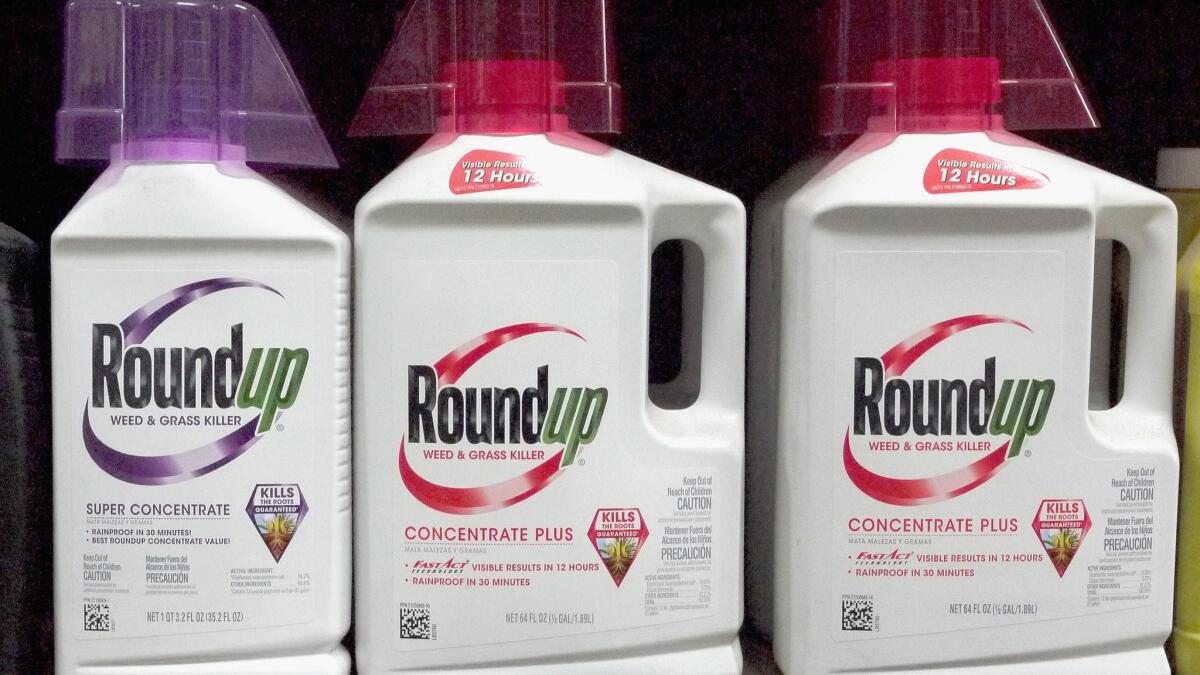Column: Did a jury ignore science when it hit Monsanto with a $2-billion verdict?

- Share via
The epic $2.055-billion jury verdict against Monsanto over accusations that its blockbuster weed killer Roundup causes cancer is just one step in a very long legal road. The company has now lost three trials in a row and is still facing lawsuits from 13,400 farmers, gardeners and other users.
If you’re in a gambling mood, you probably would do worse than to bet that Monsanto will lose every one of those cases.
The odds are good for several reasons. Rising anti-business sentiment in society at large can hardly be kept out of the jury room. Concerns about our poisoned environment are ever present. The credibility of scientists has been undermined by partisan political attacks and more general fears that we’ve lost our ability to ensure that technological advances work to our advantage.
Many judges aren’t sure that juries do get it right....There’s a reasonable concern on that front.
— Joseph Sanders, University of Houston
Those factors may be in the background of the California state court jury’s huge award against Monsanto. The foreground is that the lawsuit, which was brought by Alva and Alberta Pilliod, a Livermore couple who both suffer from non-Hodgkin’s lymphoma, hung on complicated scientific evidence over which experts themselves disagree.
The size of the verdict, which includes a $2-billion in punitive damages component that is almost certain to be sharply reduced by the trial judge or on appeal, raises an age-old courtroom question: Are juries capable of deciding complex scientific matters? Can they reliably distinguish good science from junk science, or navigate the thickets of causation and probability in product liability cases?
“Many judges aren’t sure that juries do get it right,” says Joseph Sanders, a University of Houston law professor who has studied the role of expert testimony in court. Some judges have tried to place more controls on experts, he says, “at least in part due to what was perceived as a ‘junk science’ problem. There’s reasonable concern on that front.”
The Pilliod verdict follows a victory in California state court last year for DeWayne Johnson, a Vallejo groundskeeper who said he had used the glyphosate formulation Ranger Pro for years before being diagnosed with non-Hodgkin’s lymphoma. The jury’s $289-million award was reduced to $79 million by the judge in the case, but Monsanto has appealed. Last March, a federal jury in San Francisco awarded Edwin Hardeman, who had used Roundup on his rural properties, $80 million, including $75 million in punitive damages.
It’s possible that when the science underlying a liability claim is equivocal, jurors may look for other grounds to come to a judgment — favoring a couple like the Pilliods, who are both in their 70s and facing the dismal prospects of living their lives in the shadow of cancer, against a big corporation with a rapacious image.
“We really wanted to tell Monsanto, ‘Cut it out, do better,’ and we wanted to get their attention,” juror Doug Olsen said, referring to the plaintiffs’ argument that the company had known of the hazards of Roundup and its active ingredient, glyphosate, yet resisted issuing warnings to users via product labeling. He said jurors were hoping their verdict would have a “punch-in-the-gut effect.”
The stakes in these cases are weighty. As the most popular herbicide in the world, Roundup has become an integral part of the agricultural economy. The German conglomerate Bayer, which bought Monsanto for $63 billion in 2016 just as the litigation storm was breaking, has lost about $45 billion in market value since the Johnson verdict last year. That has provoked a shareholder revolt that could take down the conglomerate’s management.
Evidence of Monsanto’s efforts to downplay or suppress scientific judgments about the hazards of glyphosate, presented in all three jury trials, fits well with prevailing public doubts about corporate morality.
Certainly there are plenty of examples of big business trying to discredit its critics. Tobacco companies spent decades, and more than $100 million, to undermine scientific findings linking smoking with lung cancer and other diseases, even as those findings became irrefutable. Exxon Mobil and its predecessor companies challenged evidence connecting fossil fuels and climate change in a 30-year publicity campaign, while their own scientists were warning about the dangers.
Monsanto’s own efforts seem indistinguishable from those of a company burdened with guilty knowledge. As we reported last year, the company has spent an average of almost $6 million a year since 2010 on lobbying in Washington. It has smeared scientists who raised questions about its products. Monsanto even enlisted a couple of obliging Republican congressmen to accuse an international science agency of manipulating data to harm the company. (The agency flatly rejected the accusation.)
Indeed, federal Judge Vince Chhabria of San Francisco, who is overseeing hundreds of lawsuits against Monsanto, observed before the Hardeman trial that despite the uncertainty about glyphosate and cancer, evidence compiled by the plaintiffs suggested that “Monsanto does not particularly care whether its product is in fact giving people cancer, focusing instead on manipulating public opinion and undermining anyone who raises genuine and legitimate concerns.”
Still, science is at the heart of the lawsuits. Efforts to reform how complex scientific evidence is presented in court have a long history. “In the 1970s, some federal courts were starting to say that some cases were so complicated that juries could not decide them,” says Michael Saks, an expert on scientific evidence at Arizona State University law school.
The argument was that might be grounds to circumvent the constitutional right to a jury; judges would handle such cases from the bench, perhaps with an “advisory jury” of scientific specialists. But the idea never took flight, Saks told me. Among other issues, plaintiffs often prefer to present their evidence to a jury of laypersons.
Jurors resent accusations that they have allowed emotion to color their judgments. “Our verdict was not flawed or inflamed by either passion or prejudice,” Gary Kitahata, a juror in the Johnson case, wrote to Judge Suzanne Ramos Bolanos in October, while she was pondering whether to reduce or set aside the jury’s $289-million verdict.
Judges do have some latitude to manage scientific evidence, especially in federal court. Federal rules allow judges to appoint their own experts to assess scientific testimony and present their opinions to a jury, but the option is seldom used. Judges also can hold a pretrial hearing to decide whether to allow, exclude or limit expert testimony.
“A civil jury verdict is little more than an advisory opinion for the judge,” Saks says. “Judges routinely reduce awards” and can even set a verdict aside. Legal observers expect the Pilliod judgment to be sharply reduced because the punitive damages far exceed the 10-to-1 ratio to compensatory damages that the Supreme Court has suggested should be the maximum.
What courts are looking for are “ways to deliver to jurors more helpful information than they’re going to get from a plaintiff or a defendant,” Saks says. “But we’re dealing with problems that have no straightforward solutions.”
That’s especially so when the science is uncertain, as it is with glyphosate and non-Hodgkin’s lymphoma. Some studies have found evidence of a link, but they’re case-control studies, in which people with a disease are asked about their past exposure to a chemical or other possible culprit.
On the other side is the Agricultural Health Study, a federally financed study that has followed 57,000 pesticide users in Iowa and North Carolina since the 1990s. The study has found “no statistically significant associations with glyphosate use and cancer.” The AHS is a “cohort” study, which tracks large populations over time to see what conditions develop. Epidemiologists generally regard cohort studies as more accurate than case-control studies, but both types have flaws.
Medical science isn’t actually sure what causes non-Hodgkin’s lymphoma, though doctors can’t rule out environmental causes. During the Pilliod trial, Monsanto argued that both plaintiffs had other conditions thought to be risk factors for the disease, including obesity and weakened immune systems.
Chhabria held several days of pretrial hearings last year to assess the conflicting evidence before allowing it to be presented to a jury. During the hearings, Chhabria was openly skeptical of some of the evidence. He said he found the evidence that glyphosate could cause the disease at conventional levels of exposure to be “pretty sparse” and epidemiology to be “a bit of a loosey-goosey field.”
He questioned how “an epidemiologist could conclude, in the face of all of the evidence … that glyphosate is, in fact, causing non-Hodgkin’s lymphoma in human beings.” But he also questioned whether anyone could conclude that it is not causing the disease. “There’s at least a strong argument,” he said, “that the only reasonable conclusion one could draw right now is that we don’t yet know.”
Chhabria barred two plaintiffs’ experts from testifying and placed limits on what others could say. But in the end he concluded that assertions of a connection weren’t so frivolous that they shouldn’t be presented to a jury to decide. In the first federal case to move ahead, the jury awarded Hardeman $80 million. Chhabria hasn’t yet said whether he will review the verdict. Monsanto says it will appeal.
In litigation where high stakes compete with uncertain science, the best option may be to keep the issues out of jurors’ hands entirely, perhaps by crafting a mass settlement that relieves the court system of decisions it’s ill-equipped to make, while offering deserving plaintiffs some compensation.
Chhabria pointed to that option last month, weeks before the scheduled May 20 start of the second trial on his Monsanto docket. He canceled the trial and ordered the plaintiff and defense lawyers to move to “confidential mediation.” If the parties can’t agree on a mediator, he said, he’d appoint one himself.
Keep up to date with Michael Hiltzik. Follow @hiltzikm on Twitter, see his Facebook page, or email [email protected].
Return to Michael Hiltzik’s blog.
More to Read
Inside the business of entertainment
The Wide Shot brings you news, analysis and insights on everything from streaming wars to production — and what it all means for the future.
You may occasionally receive promotional content from the Los Angeles Times.











